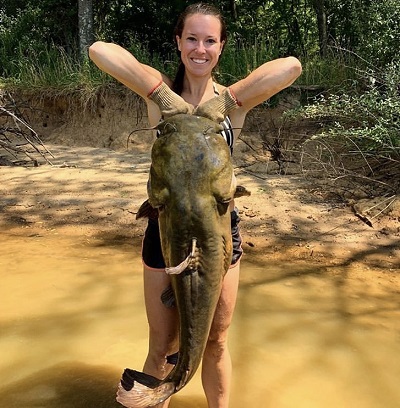I received a call from some of my best friends, saying I needed to get to their house ASAP.
When I pulled into the driveway a few minutes later, I saw one of the biggest fish of my life lying in front of the garage.
They had noodled a flathead catfish that weighed 50 lbs!
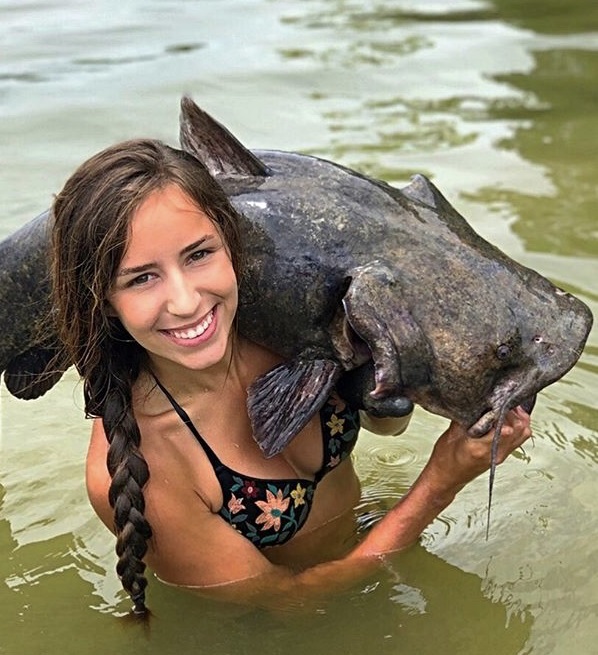
Flathead catfish can grow to enormous sizes, like this one, held by Aly Hall (Aly from Alabama).
The mind blowing thing about the situation is that they didn’t even break the record for the biggest flathead catfish to be brought out of our local lake.
So, as you can imagine, flathead catfish can grow to incredible sizes and weights.
“Pylodictis” is Greek for “mud fish” and “olivaris” is Latin for “olive-colored.”
How Big Do Flathead Catfish Get?
Flathead catfish (Pylodictis olivaris) are the second largest species of catfish in North America (second to the blue catfish).
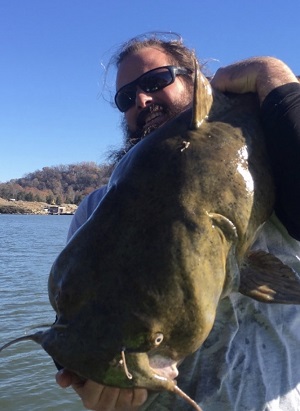
Flathead catfish are a favorite among many fisherman (like Spencer Hardin here), especially in the eastern U.S.
Flatheads have several other nicknames such as shovelhead cats, yellow catfish, mud cats, Opelousa Catfish, Opp, Appaloosa Catfish, App, and Pied cats. They are also sometimes referred to as goujan, and johnnie cats.
According to the Indiana Division of Fish & Wildlife, the flathead catfish got their name due to their broad and flat-looking heads. They have a lower jaw that protrudes and a tail that is slightly forked.
The back and sides of a flathead catfish range from pale yellow to light brown and have splotches ranging from dark brown to black. They have a yellow-ish and/or cream-colored belly.
According to the International Game and Fish Association, the world record flathead catfish weighed 123 lbs. It was caught in the Elk City Reservoir near Independence, Kansas.
Compared to other popular game fish species such as bass, crappie or bream, flathead catfish are enormous. For example, the Kansas state record for largemouth bass is just 11 lbs 12.8 ounces.
Due to their enormous growth potential, it’s easy to see why fishermen love trying to catch monster flatheads.
Catfish can be caught using a variety of tactics which means the potential to have more opportunities to consistently catch fish. Check out some of the methods below!
Why Fish for Flatheads?
Fishing for catfish is extremely fun and easy to learn. Unlike many other styles of fishing, catfishing doesn’t require a ton of gear.
Flatheads put up a solid fight and they taste great! When you’re in desperate need of a meal, catfish are an outstanding food source.
Ideally, when fishing for food, smaller fish are preferred. However, large flathead catfish can provide you with several meals and not forfeit the quality of flavor.
How to Fish for Flathead Catfish
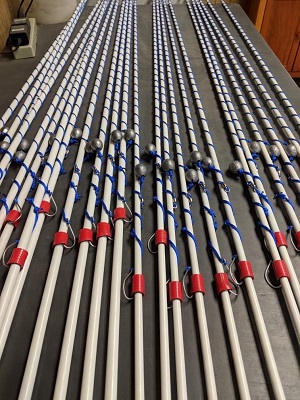
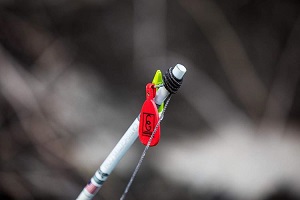
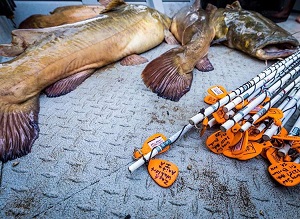
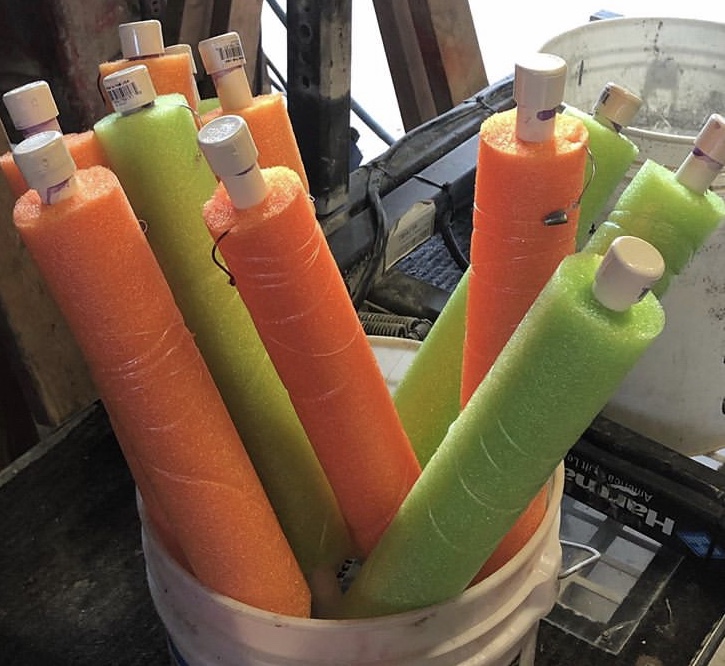
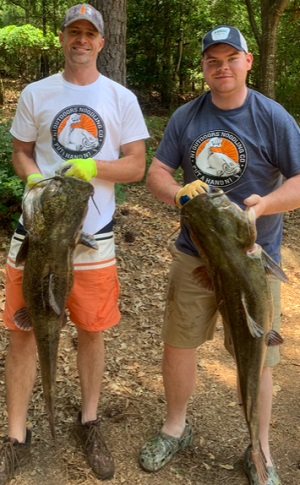
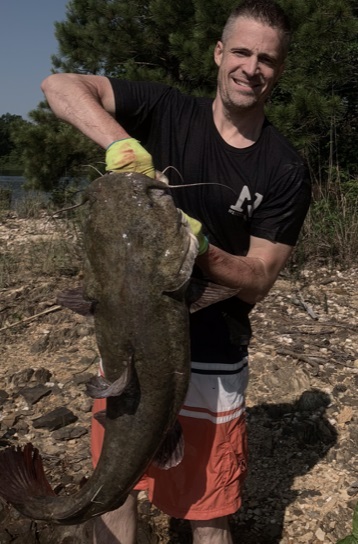
There are a vast number of ways to fish for flatheads. Fishing regulations vary from state to state on how you can legally catch flathead catfish, so be sure to check your state’s regulations before you try a new technique.
- Rod and reel: When we think of fishing, this is typically what we picture in our minds. Using a rod and reel, fishing line, weights, hooks, swivels, and bait. Cast out a line, put a hook N1, and reel in the fish. No boat required!
- Bank poles: Using a bank pole is a great option when you don’t have a boat. You will need PVC, fiberglass, or similar material for the pole. The line length will be determined by where you are fishing, as well as what weights, hooks, swivels, and bait you want to use. Tie the line to the pole and find the ideal spot to push the pole(s) into the bank and let the line out. Sit back and let the fish find the bait!
- Limb lines: Making a limb line is pretty simple and can lead to catching lots of catfish. You need line, weights, hooks, swivels, bait, and a boat. The length of the line will depend on the depth of the water you plan to fish. Keeping your bait just off the bottom is ideal. Find a strong limb overhanging the water where catfish are known to be and tie the line to the limb. Now relax and wait! Check your limb lines every couple hours!
- Trotline: Trotlines are similar to limb lines, in that you are typically tying the line to a couple of trees. Stretch the line to whatever length you need to be able to tie it to a couple of trees or anchor points. Tie on drop leaders and swivels about 3 feet apart. Then, attach hooks, weights, and bait. Find a couple of solid anchor points and tie each end of the line to them and wait!
- Jugs: You will need a boat for this technique as well. You can use old jugs, pool noodles for “jug fishing.” There are also companies that manufacture ready-to-use products for this type of fishing. Tie a line to the jug (the length will be determined by the depth of water you are in). Then, tie a weight and hook to the line and place the bait on the hook. Find the best spot possible to place the jugs and get after it!
- Noodling (hand-fishing): This is how my friends caught that 50 lb monster flathead cat. Very little equipment is needed. Some people have become famous on social media for noodling catfish. However, bravery and strength is a must! Find an underwater hole or overhang where flathead catfish will nest and shove your hand into the hole. If there is a fish in the hole, you will feel it, or it will bite your hand. When it bites your hand grab ahold of its lower jaw and pull it out of the hole. Watch out catfish are extremely slippery. Be sure you have a good grip on the fish or it will get away! (Before noodling you should first be sure it’s legal in your state!)
What Do Flatheads Eat?
Flathead catfish are opportunistic feeders. Like other species of catfish, they will scavenge for their meals. However, they prefer to ambush smaller live fish such as shad, crappie, sunfish, white bass, etc.
Flatheads are aggressive and will eat just about anything that they can fit into their mouth. Small flatheads will eat worms, crawfish, insects, and minnows.
When choosing a bait to use to catch a flathead, try to use common baitfish or chunks of baitfish. Shrimp, chicken liver, and other stink baits often work. Since they prefer live food, try to stick with using live bait.
Flathead catfish themselves do not have many predators to speak of, but other fish will eat young catfish as well as some fish-eating birds.
Where Do They Live?
The Texas Parks & Wildlife states that flathead catfish prefer deep, slow-moving pools of murky water during the day. At night, they will move up into shallower water to feed.
They are typically found at the mouths of creeks, rivers, in lakes, and below lake dams. Flatheads hide under cover such as sunken trees and underwater overhangs where they can ambush their next meal.
Flatheads are found throughout the Mississippi River watershed and the lower Great Lakes.
Many fishermen across the eastern half of the United States target flathead catfish.
Because they are fun to catch and also adapt well, they have been introduced into bodies of water where they are not native and have begun to hurt populations of other species of fish.
-
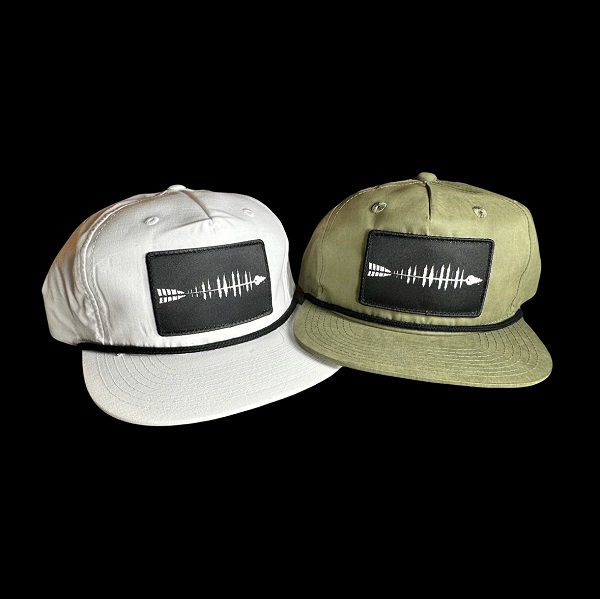
N1 Outdoors® Fish Arrow Patch Rope Hat
$29.99 Select options This product has multiple variants. The options may be chosen on the product page -
Sale!
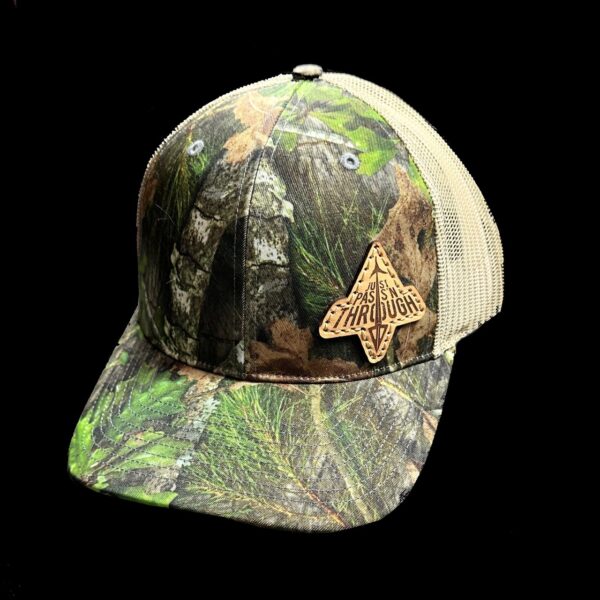
N1 Outdoors® Just Pass’N Through™ Leather Patch Hat (Mossy Oak Obsession/Khaki)
Original price was: $29.99.$19.99Current price is: $19.99. Select options This product has multiple variants. The options may be chosen on the product page -

N1 Outdoors® RodTogs™ Patch Trucker Hat (White)
$26.99 Select options This product has multiple variants. The options may be chosen on the product page
Flathead lifespan
The Texas Parks and Wildlife also states that the average lifespan of flathead catfish is 12 to 24 years, although there has been a flathead that lived for 24 years.
Flatheads spawning begins in the Spring as water temperatures rise. The month can vary depending on location, as bodies of water that are further South would typically warm sooner than those further North. Spawning months range from April all the way to even August in some cooler locations.
Final Thoughts On Flathead Catfish
If you have never taken the opportunity to catch a flathead, you are missing out. Catching a catfish is always a thrill and doesn’t require an enormous amount of gear.
You can be at your local lake, river, creek, or pond catching catfish in no time at all. After reading this article, you now have some basic knowledge and understanding of flathead catfish and how to catch one for dinner tonight! Head to the water and get fishing… I hope you Put A Hook N1!

